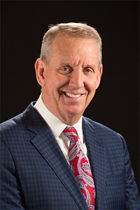Richard Andersen, CVE, is one of those individuals blessed to have worked in most sectors that the public assembly venue world offers. With a background immersed in arenas, stadiums, ballparks, fairgrounds, and more, it is safe to say that Andersen can separate what is unique between venue types and what elements cross over from one sector to the next.
When he serves as the keynote speaker for the Amphitheaters & Fairgrounds sector on Tuesday, July 24, from 9:15-10:15 am (ET) at VenueConnect in Toronto, he sees this presentation as one that can rally attendees from across the sector spectrum.
“Definitely,” said Andersen, a past IAVM chairman and current president and CEO of Seattle-based Seafair. “I come from that background (most recently with Alberta-based Northlands) and was fortunate to run a  large fairgrounds in Canada. I certainly understand the trials and tribulations of running an amphitheater and running a fairground. Having said that, this session will be valuable for leaders from all types of venues.”
large fairgrounds in Canada. I certainly understand the trials and tribulations of running an amphitheater and running a fairground. Having said that, this session will be valuable for leaders from all types of venues.”
Andersen’s “When Team Does Have An I” will have a situational leadership focus, he said. Andersen said that this interactive session will explore how leaders can be adaptive to the current work climate we live in.
“There are typically a couple of trains of thought,” Andersen said. “One is that this is the way I am as a leader, so therefore all the people that like my style will be just fine. That works a little bit in some areas but typically employees are afraid to be vulnerable to really tell you the truth, especially when they have to adapt to a specific style that they may not be comfortable with. The situational leader is one that learns to look at any given situation and diagnose what the issue is.”
When Andersen speaks of diagnosing, he explains it by saying it is important to know what NEEDS to happen in order for a job project to have a successful outcome with a particular person doing a particular job. In his experience serving on the faculty of the Venue Management School at Oglebay and at the VMA School in Australia, Andersen said that a common refrain deals with leadership styles and the various aspects of it that leaders struggle with or in some cases have success with.
“Generally, it is around things that aren’t working for them as well as they want,” Andersen said. “The question became, is there a preferred style of leadership? I was asked to look at that. We will talk about four distinct styles of leadership that any leader can fit into. We will walk through each of those styles and show how easy they are for anyone, even someone inexperienced, to adapt these highly successful ways in their workplace to create an enhanced culture and better outcomes, reduce stress, and increase the joy meter. It is a simple applicable system that is tried-and-true. It is tested and has worked famously for all sorts of great leaders.”
As for successful outcomes on the job, Andersen cited an example whereby a leader might ask an employee talented at writing press releases to write one, but on a subject matter totally foreign to the writer.
“The point is there’s different strokes for different folks on different things,” Andersen said. “You are not just delegating everything because somebody is a good guy. You might say, I appreciate you have confidence in me but you are asking me to do something and I don’t know how to do it. I want to be good at it. If you don’t employ the right leadership style or technique to the given situation, it can create a lot of fear and consternation and then frustration for the employee. It requires a good analysis, good diagnosis of what the situation is and you being able to flexibly adapt the various leadership styles that might fit.”
Andersen said that he will address the four situational leadership styles of Directive, Coaching, Supporting, and Delegating. “There is a clear and simple system for taking any given situation and applying it to the person and situation,” he said.
“We will have a fun and engaging time that is hands-on to get people involved,” Andersen said. “That is the way I like to facilitate. I will share some stories and some insights but this will be a highly engaging and fun, interactive session. When it is said and done, people should have a couple of tools they can put in their toolkit and take home and immediately find ways to enhance the outcomes they are trying to achieve from work.”
